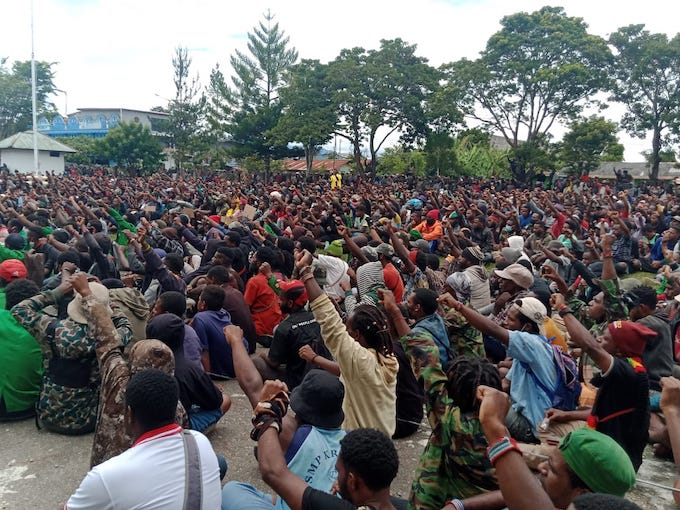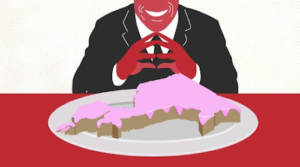
On Thursday, 10 March 2022, thousands of Papuan people in the Lapago Wamena Cultural Area took to the streets to paralyse Wamena city. They occupied Wamena City. They rejected the Indonesian colonial plan to expand Papua province.
Remember: The voice of the people is the voice of God. The Papuan people, people and leaders of Indonesia, Melanesia, Pacific, Africa, European Union. USA, Australia, listen to the voices of the two million Melanesian people in West Papua who are currently on their way to being annihilated due to Indonesia’s systemic racist politics.
The expansion of Papua provinces, Special Autonomy Volume 2 and military operations in six regencies in Papua is not a solution for West Papua. Only one order — give us the right of self-determination for the political rights of the Papuan nation in West Papua.
Our greetings and prayers from Wamena, the heart of Papua.
Waaa … waaa … waaa.
SPECIAL REPORT: By Yamin Kogoya
The above text was written by Markus Haluk, director of the United Liberation Movement for West Papua (ULMWP) on Thursday, March 10. The text encapsulates the sentiments of Papuans protesting across West Papua and Indonesia, calling for Jakarta to stop the creation of new provinces.
Haluk’s words were written amid escalating protests in various parts of West Papua’s customary lands and across Indonesia over Jakarta’s plans to create six new provinces under the unilaterally renewed — and unpopular — Special Autonomy Law 21/2001.
15/3/22 Yahukimo, West Papua
Indonesian forces shot dead Yakub Meklok (39) and Herson Wisapla (21) during forced dispersal of thousands of people protesting against Jakarta’s plan to create new provinces.
At least ten others were shot including LK (21), SK (21), and AI (23). pic.twitter.com/rFQEVkthd2
— Veronica Koman 許愛茜 (@VeronicaKoman) March 15, 2022
Here is an overview of the breadth and depth of protests against this repression, with reports that at least two people have been shot dead:
8/3/22 Jayapura, West Papua
Fully armed police and soldiers forcibly dispersing peaceful protestors against Jakarta’s plan to create new provinces. pic.twitter.com/jmz0u6K3C8
— Veronica Koman 許愛茜 (@VeronicaKoman) March 8, 2022
Jayapura – Mamta customary land
Tuesday, March 8: Hundreds of students and communities clashed with Indonesian security forces at university campuses in Waena and Abepura cities, protesting against the expansion. The protest coordinator, Alfa Hisage, stated that this demonstration was to reject the creation of a new province altogether.
Wamena – La Pago customary land
Thursday, March 10: Doni Tabuni, the coordinator of the demonstration in the highlands of Wamena (the location that Markus Haluk refers to in his text) warned on March 10 that the expansion would wipe out Papuans. Protesters declared: “We will stop all government office activities in the Lapago region if the central government does not stop the expansion,” reported CNN Indonesia (10 March 2022).
“The expansion will not bring prosperity to Papuans; it will only serve to benefit the elites, bring more migrants, and create more opportunities for military and human rights violations,” said Doni Tabuni.
14/3/22 Paniai, West Papua
Hundreds of West Papuans protested against Jakarta’s plan to create new provinces – which will lead to further dispossession and militarisation.
The protests this month are the largest since the 2019 West Papua Uprising. pic.twitter.com/vydPsIj2bP
— Veronica Koman 許愛茜 (@VeronicaKoman) March 14, 2022
Paniai – Meepago customary land
Monday, March 14: thousands of residents of Paniai took to the streets to demonstrate against the expansion of the “New Autonomous Region”, also known as “Daerah Otonomy Baru” (DOB). The demonstrators repeatedly shouted against the new proposal and do not want to join the province of Central Papua, which would become a new autonomous region.
Petrus Yeimo, a member of the Paniai Regency Legislative Council (DPRD), said that communities are not involved in the formation of this new region.
“That’s why we Paniai people firmly reject the expansion,” said Petrus, when he was met by the mass in front of the DPRD office (innews.id).
West Papuan women against the creation of new provinces by Jakarta that will cause further dispossession and militarisation.
Manokwari, 8/3/22#IWD2022 pic.twitter.com/OdAyPdXl3L
— Veronica Koman 許愛茜 (@VeronicaKoman) March 8, 2022
Manokwari – Domberai customary land
Tuesday, March 8: The same message also echoed in Manokwari city — a coastal town popularly known as a “city of the gospel” for its historical significance of the landing of the first two German missionaries (C.W. Ottow and J.G. Geissler) for the “Christianisation” project in the mid-1800s.
17/3/22 Sorong, West Papua
Another big protest against Jakarta’s plan to create new provinces.
Protestors: “Papua! Freedom!” pic.twitter.com/95WJoIyf8P
— Veronica Koman 許愛茜 (@VeronicaKoman) March 17, 2022
Sorong – Domberai customary land
Monday, March 21: A series of protests has also taken place in Sorong city, at the Western tip of West Papua, involving sections of Papuan society, including students and communities.
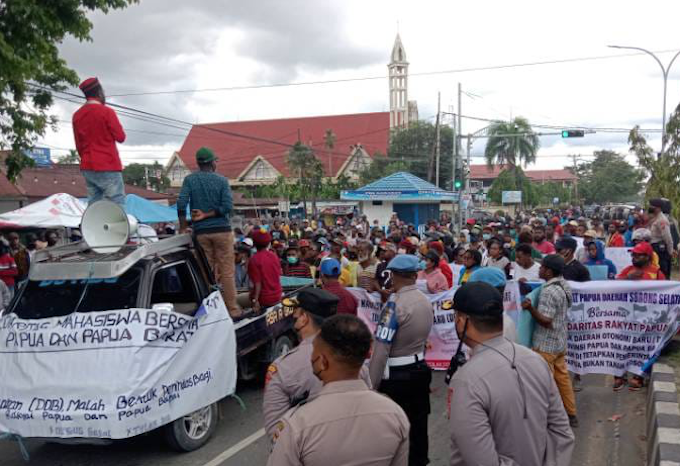
“The expansion of new autonomous region depletes our forests, depriving us of our land rights. The goal of our meeting is to convince the mayor, who is also the head of the creation of the new Southwest Papua province that we Papuans all over Sorong Raya oppose the expansion,” said action coordinator Sepnat Yewen on Monday. But they were disappointed that they were unable to see the mayor twice (Compass.com, 21 March 2022).
11/3/22 Jakarta
102 West Papuan students were forcibly dispersed and arrested during a protest. They reject Jakarta’s plan to create new provinces in West Papua that would lead to further dispossession.
(Soldiers that many at a protest is not common.) pic.twitter.com/OeIpQhHuCh
— Veronica Koman 許愛茜 (@VeronicaKoman) March 11, 2022
Jakarta – the heartland of the colonial powerhouse
Tuesday, March 11: Papuan students held protests in central Jakarta, calling on Jakarta to stop the colonial expansion of their homeland, during which one police officer, Ferikson Tampubolon, was injured on the head (Detiknews, 12 March 2022).
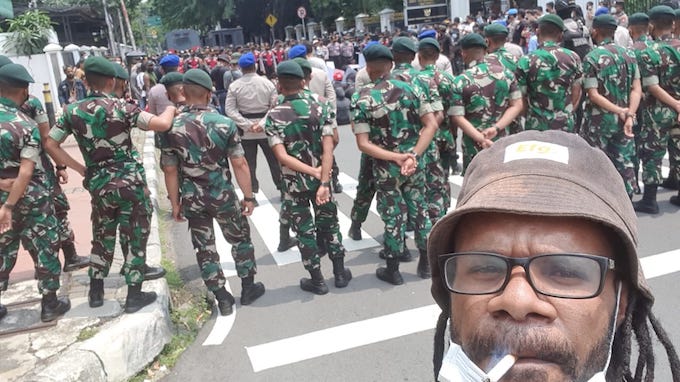
South Sulawesi – an Indonesian island
In Kendari city of South Sulawesi, the Papuan Student Association declared that the newly created provinces would not benefit Papuans. Kiminma Gwijangge, the group coordinator, said that this was a game of the political elites and rulers who control the public service in Papua and ignoring the rights and wishes of Papuans. These Papuan students demanded that the Papuan elites, who eat money and expand on behalf of Papua, be stopped immediately.
15/3/22 Yahukimo, West Papua
Earlier today, speaker: “people reject expansion, people want independence”.
Series of protest this month are the largest since the 2019 West Papua Uprising. https://t.co/wlJZRrFM4F pic.twitter.com/HBCnpuCH0e
— Veronica Koman 許愛茜 (@VeronicaKoman) March 15, 2022
Yahukimo – La Pago customary land
Tuesday, March 15: Tragically, a peaceful demonstration for the same cause in the Yahukimo region did not go well. Two young men, Yakop Deal, 30, and Erson Weipsa, 22, have been martyred for this cause by the Indonesian police — the cause for which Papuan men and women courageously risked their lives to fight against fully armed, western-backed, modern security forces with advanced mechanical weapons.
Two young Papuans gunned down and a dozen wounded
Witness accounts of the Yahukimo tragedy stated that the protest initially went ahead safely and peacefully. However, provocation by police intelligence officers posing as journalists in the midst of the protest led to the shooting.
It is alleged that an unidentified Indonesian person flew a drone camera during the demonstration. Seeing that action, protesters warned the Indonesian man not to use drones to record the protest, creating fear.
The protestors also asked for his identity and whether or not he was a journalist, but he failed to respond. The crowd protested against his action. He then ran for cover towards hidden police officers who had been on standby with weapons. Immediately, members of the police fired tear gas at the crowd without asking for the person responsible for the peaceful demonstration. Soon after, police opened fire on the crowd.
Papuan Police public relations chief Kombes Pol Ahmad Musthofa Kamal confirmed that two protesters had died, and others suffered gunshot wounds (Suara.com).
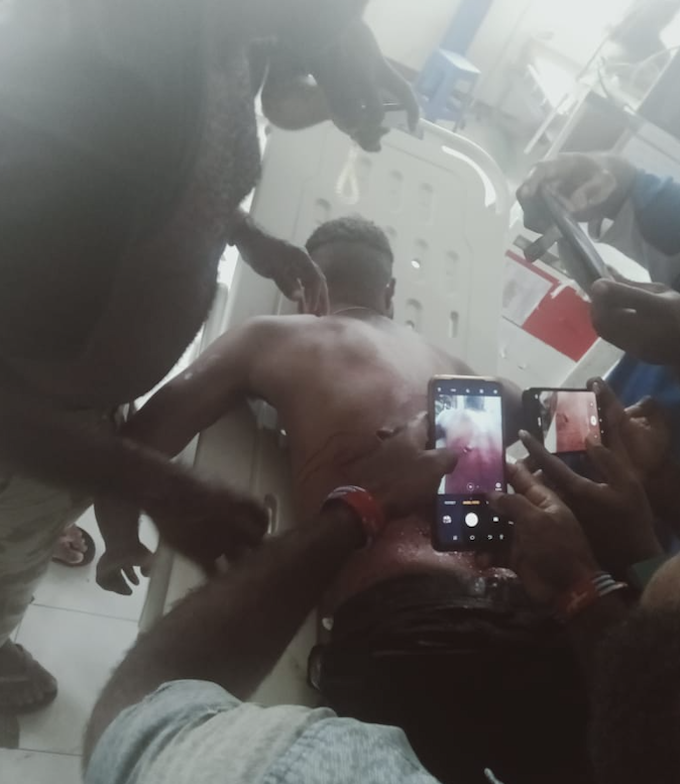
OPM and civil society groups
The Free Papua Movement, also known as Organisasi Papua Merdeka (OPM), and their military wing, The West Papua National Liberation Army, which was launched in the 1960s to protest against the Indonesian invasion, are opposed to the new expansion of provinces.
Sebby Sambon, the group spokesperson released a statement that threatened to shoot Papuan elites who imposed Jakarta’s agenda onto Papuans (tribunnews.com, 12 February 2022)
More than 700,000 people have also signed the Papuan People’s Petition which represents 111 organisations opposing Special Autonomy.
These protests are not the first and they will not be the last. Papuans will continue to resist any policy introduced by Jakarta that threatens their lives, cultural identities, and lands.
This is an existential war, not a political one — it is a war of survival and resisting extinction.
The genesis of these recent protests
Those protests are not simply a reaction against the new expansion, but a part of a movement against the Indonesian invasion that began when Papuans’ independent state was seized by the Western governments and given to Indonesia by the United Nations in 1963.
This is a conflict between two states — the state of Papua and the state of Indonesia.
Having the big picture is vital to prevent misrepresentation of these protesters as just another angry mob on the street demanding equal pay in Indonesia.
However, the protests that cost those two men their lives in Yahukimo had a specific genesis. It began in 1999 when 100 Papuan delegates went to then-President Habibie and demanded independence after the collapse of Suharto’s 31-year New Order regime.
Habibie and his cabinet were shocked by this demand, as people whom they thought were members of his family suddenly told him they no longer wanted to be part of the great Indonesian family.
Having been shocked by this unexpected news, Habibie and his cabinet told the Papuan delegation to go home and think it over in case it had been a mistake. But this was not a mistake. It was the deepest desire of Papuans being communicated directly in a dignified manner to the country’s highest presidential palace.
This occurred during a time of great turmoil in Indonesia’s history. Strongman national father figure Suharto, once considered immortal, no longer was. His empire had crumbled.
Suddenly, across the archipelago, a cacophony of demonstrators unleashed more than 30 years of dormant human desires for freedom, frustrations, and fear, combined with the ravages of the Asian economic collapse.
If there was a time when the Papuans could escape the tormented house, this was it. One hundred Papuan delegates marching to Habibie indeed made their mark in that respect.
At this momentous time, the man who understood this deepest desire and would help Papuans escape was President Abdurrahman Wahid, better known as Gus Dur. He lives on in the memories of Papuans because of his valiant acts.
President Gus Dur – a political messianic figure
On 30 December 1999, or exactly two months and 10 days after being inaugurated as the 4th President, Gus Dur visited Irian Jaya (as it was known back then) with two purposes — to listen to Papuan people during the congress, which he funded, and to see the first millennium sunrise on January 1, 2000. On this day, a significant moment in human history, he chose to stand with Papuans and for Papuans.
During his stay, he changed the region’s name from Irian Jaya to Papua and allowed the banned Papuan Morning Star flag to be flown alongside Indonesia’s red and white flag.
Changing the name was significant for Papuans because these changes marked a significant shift in how the region would be governed. The former name symbolised Indonesia’s victory and the latter symbolized Papuan victory.
Prior to these historical occurrences, the region was known as Netherlands New Guinea during Dutch rule, then as West Papua during a short-lived, Dutch-supported Papuan rule in 1961, then from Irian Barat to Irian Jaya when Indonesia annexed it in May 1963.
Just as their island has been dissected and tortured by European and Asian colonial powers, so too have Papuans, being tortured with all manner of racism and violence in the name of the civilisation project.
The messianic Gus Dur’s spark of hope instilled in the hearts of Papuans was short-lived. In July 2001, he was forced out of office after being accused of encouraging Indonesia’s disintegration. Gus Dur’s window of opportunity for Papuans to escape the tortured house was closed. The new chapter that Gus Dur wrote in Indonesia-Papua’s tale of horror was ripped out of his hands during the most pivotal year of human history — the new millennium 2000.
The demand for independence conveyed to President Habibie a year earlier by one hundred Papuan delegates was discarded. Instead, Jakarta offered a special gift for Papuans — gift the Special Autonomy Law 21/2001.
There was a belief among foreign observers, and Papua and Jakarta elites that this would lead to something special. It reflects Jakarta’s ability in terms of its semantic structure and highly curated selection used in law.
Rod McGibbon, an analyst and writer on Southeast Asian politics in Jakarta, noted in a Wall Street Journal article on 14 August 2001 that despite the challenges Jakarta faces in its dealings with Irian Jaya (Papua), the Special Autonomy approach represents the best opportunity for Jakarta to begin meaningful dialogue with provincial leaders. He also predicted that if Jakarta fails special autonomy, the province will suffer further ethnic and regional conflicts in the future.
He was right, 20 years later Special Autonomy turned out to be a big mess.
The law consisted of 79 articles, most of which were designed to give Papuans greater control over their fate — to safeguard their land and culture.
Furthermore, under this law, one important institution, the Papuan People’s Assembly (Majelis Rakyat Papua-MRP), together with provincial governments and the Papuan People’s Representative Council (Dewan Perwakilan Rakyat Papua-DPRP), was given the authority to deal with matters that are most important to them, such as land, population control, cultural identity, and symbols.
Section B in the introduction part of the Special Autonomy law reads as follows: “That the Papua community as God’s creation and is a part of a civilised people, who hold high human rights, religious values, democracy, law and cultural values in the adat (customary) law community and who have the right to fairly enjoy the results of development”
Assassination of prominent Papuan leader and Papuan chief
Three weeks after the law was passed, popular independence leader Theys H. Eluay was killed by Indonesian special forces (Kopassus). Ryamizard Ryacudu, then-army chief of staff, who in 2014 became Jokowi’s first Defence Minister, later called the killers “heroes” (Tempo.co, August 19, 2003).
In 2003, the Megawati Soekarnoputri government divided the province into two. She was violating a provision of the Special Autonomy Law, which was based on the idea that Papua remains a single territory. As prescribed by law, any division would need to be approved by the Papuan provincial legislature and MRP.
Governor Lukas Enembe – Melanesian chief
On August 22, 2019, Narasi (central Jakarta’s TV programme) invited Papua provincial Governor Lukas Enembe and others (both Papuans and Indonesians) to discuss mass demonstrations that erupted across West Papua and Indonesia after Papuan students were racially attacked in Surabaya.
The programme host, Najwa Shihab, was shocked to hear the governor’s response. When asked about his opinion about the situation, the governor said that Papuans already had their own concept to address problems in West Papua, but they needed an agreement/treaty under international auspices — or something of the sort — because no Jakarta-made law would work in Papua.
The host then asked, “you are a governor, but why don’t you believe the authority of Special Autonomy Law?” Governor Enembe replied, “The Special Autonomy Law 21/2001 has not worked until now.”
The governor stressed that Papuans do not have political power or free will to make any meaningful decision.
“We are supposed to make our own law under this Special Autonomy, but Jakarta refuses to allow it. Jakarta only gives money under this law, that’s all.”
The statements come from Papua’s number one man and not from someone on the street. The ruling elites in Jakarta are not fazed about breaking their own laws, showing their disrespect of the Papuan people and their integrity as a nation.
The governor is not the only official in the country’s highest office who lacks faith in the central government. Otopianus Tebai, a young Papuan senator who represents Papua in the central government said in a response to this new expansion plan that most Papuans reject the divisions (Suara.com, March 18, 2022). Divisions of which Papuans are being coerced into by the old special autonomy law renewal, which Governor Enembe declared as a total failure.
The MRP, Papua’s highest institution established under the special autonomy law to safeguard cultural identities, no longer has the power to act as intended. This institution has been stripped of its power, as well as other things, as a result of the 2021 amendment to the law which was passed two decades ago.
Timotius Murib, the chairman of this institution, said that the plan to create an autonomous region did not reflect the wishes of the people of Papua and would probably create more problems if Papuans were divided over it.
The chairman emphasised the law was designed for Papuans to have specific authority to implement local laws pertaining to our affairs, but the central government removed that authority by destroying any legal or government mechanism that materialised this authority.
Adding to these statements from the highest offices, more than 700,000 people have signed the Papuan People’s Petition, which represents 111 organisations opposing Special Autonomy.
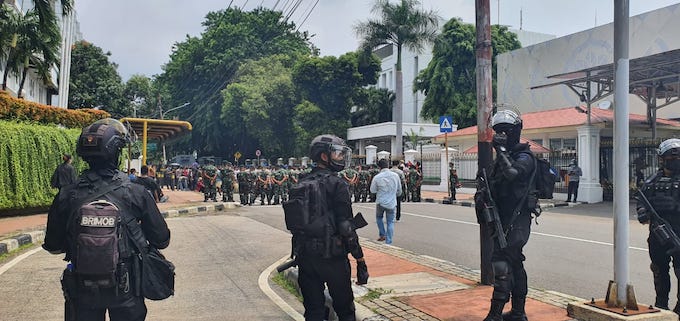
Deep psychological war against Papuans – ‘divide and rule’ tactic
Despite overwhelming opposition from many segments of Papuan society, the Indonesian government persists in imposing its will upon Papuans. It is precisely this action that is causing protests and havoc in recent weeks.
But not all Papuans are against it. Several regents (mostly Papuans) are supporting this expansion with their cronies and supporters, in conjunction with the Indonesian government, a few Papuan elites in Jakarta, and other misfits and opportunists.
The issue has caused division among indigenous Papuans. Among the Papuans, it plays directly into identity politics, as many tribes speak different languages, live in different ancestral and customary lands, and even practise different religions.
A protracted horizontal conflict between these languages, cultural, and geographical lines was already being created by the creation of more regencies and districts in the past. Adding three new provinces would lead to more regencies, which means more districts, which means more security forces and settlers and more problems.
In the midst of this drama, Jakarta is setting traps for Papuans by forcing them to face each other and preventing them from collectively confronting the system that is tearing them apart. The creation of more provinces and regions is leading to such traps since this will divide the people — which is clearly Indonesia’s ultimate goal.
If Papuans are too busy fighting one another, then the atrocities of the elites will fly under the radar, unopposed. What West Papua needs is unity, which has been demonstrated in recent protests. Together, Papuans will always be stronger than apart in their cause, and Jakarta will stop it with all its tricks.
If you are an imperial strategist or scammer in an empirical office somewhere in London, Canberra, Washington DC, or Jakarta, you might think that this is the best way to control and destroy a nation.
But history shows that, all dead ancient empires and the current dying Anglo-American led Western empires use this little magical trick “divide and rule” over others until it collapses from its wicked pathological and hypocritical weights from within.
Imperial planners in Jakarta should be focusing on overcoming their own internal weaknesses that would eventually bring them down rather than chasing after the monster they created out of West Papua.
In this frame of mind, any vestige of hope for Papua’s restoration and unity, whether contained within or outside the law, is a threat that will be undermined at any cost.
The term autonomy is also defined differently in Papua’s affairs because Jakarta does not intend to empower Papuans to stand on their own two feet.
There is no real intention for Jakarta to give Papuans a chance to have some level of self-rule, which is exactly what being autonomous means in essence.
Papua’s autonomous status seems to be all part of the settler-colonial regime: occupation, expansion, and extermination. Papuans have been told that West Papua is special, but Jakarta is undermining and paralysing any mechanism it agrees upon to convince them that that is truly not the case.
In other words, Jakarta introduces a law, but it is Jakarta that violates it. The situation is analogous to students having a teacher who is not just negligent but hypocritical; everything the teacher believes in, they teach, not taking time to critically analyse their actions and how it all contradicts itself.
Under the whole scheme, Indonesia is presented as a self-appointed head of the class that they are holding hostage. They believe they are the only ones capable of teaching the stupid Papuans, of civilising the naked cave men, of saving the wild beasts, and developing the underdeveloped people.
But under the guise of the pathological civilisational myths, Jakarta poisons and destroy Papuans with food, alcohol, drugs, pornography, gambling, diseases and the ammunition which is used against them.
Rulers in Jakarta act as narcissistic sociopaths — they promise development, happiness, or even heaven while committing genocidal and homicidal acts against Papuans.
They portray themselves as the “civilised” and the Papuans as the “uncivilised” – a psychological manipulation that allows them to avoid accountability for their crimes. Jakarta makes Papuans sick, then prescribes medication to cure the very same illness it caused.
A deep psychological game is being played to convince themselves (colonisers), and the Papuans (colonised) that Indonesia exists so that West Papua can be saved, improved, and developed. This pathological game is then embedded into the psyche of Papuans through all the colonial development products Jakarta sells to Papuans through education and indoctrination.
This programming is evident in the way that a few Papuans (with Jakarta acting as the puppeteer) fool their own people by telling them that Indonesian rule will bring salvation and prosperity.
Even the mental work of most Indonesians is being reprogrammed to view West Papua with that lens – they believe that Indonesia is saving and improving West Papua. Unbeknownst to them, this entity called “Indonesia” annihilates Papuans.
Local Papuan elites legitimize their power by saying that their own people also have serious problems (backwardness, stupidity, poverty) and that they have solutions to solve these problems. However, the solution is Jakarta-made, not Papuan-made, and that is the problem.
When governor Enembe said we need an international solution rather than a national one, he was conscious of these games being played against his people in his homeland.
The Indonesian government exterminates Papuans by controlling both poison and antidote, but there is no antidote to begin with. It is all poison; the only difference is the label.
Markus Haluk’s words
Markus Haluk’s words make a desperate plea for help as they face what he terms “annihilation” due to Indonesia’s racism, responding to mass demonstration in his own homeland.
His words highlight that the only viable solution is to grant the people the right to self-determination to establish their nation-state and declare that the people’s voice is the voice of God.
As tragic and ironic as it is, it is highly unlikely that Haluk’s words “the voice of the people is the voice of God” will mean anything to the ruling class in Jakarta since in the past 20 years all the attacks, betrayals, torture, racism, and killings have been committed after these words were written on the Special Autonomy Law No 21/2001.
Section B in the Introduction part of the law reads: “That the Papua community as God’s creation and is part of a civilized people, who hold high Human Rights, religious values, democracy, law and cultural values in the adat (customary) law community and who have the right to fairly enjoy the results of development.”
It seems that these words are merely part of the theatrics — the drama of cruelty, torture and death.
The full English text of the law can be accessed here: Refworld | Indonesia: Law No. 21 of 2001, On Special Autonomy for the Papua Province
Settler-colony – the logic of ‘destroy to replace’
Indonesia’s occupation in West Papua is not temporary — they are not simply taking resources and going home. The Indonesians want to make West Papua their permanent home.
This is a permanent population resettlement colonial project based on the logic of destroy to replace. Papuans are being destroyed — and even worse, they are being replaced by Indonesian settlers. They are powerless to stop the annihilation and perversion of their ancestral homelands.
To occupy and own the land is the ultimate goal of settlers. Settler states aim to eradicate Indigenous societies through what an Australian historian and scholar, Patrick Wolfe, refers to as a the “logic of elimination” in his paper, Settler colonialism and the elimination of the native (2006).
Colonialism through population resettlement is the most destructive form of colonial project underpinned by self-righteous, pathological rationality which exterminates the original inhabitants as a moral requirement to justify the process of replacing itself.
In this pathological project, genocide is not considered evil but a necessity to achieve its exterminating objective. That is why the assassination of Theys H. Eluay just three weeks after the passing of the Special Autonomy Law was perhaps seen as a necessary evil to satisfy this colonial project.
West Papua: not just another one of Indonesia’s provinces
Over the past 60 years, virtually all literature ever produced on West Papua failed to refer to it as a settler colony. The region is still treated as if it were just another province of Indonesia, and Jakarta insist on creating more provinces as if they have legal and moral rights. This is misleading and illegal considering Indonesia’s genocidal actions and the circumstances in which the region was incorporated into Indonesia in the 1960s.
Indonesia did not merely incorporate West Papua; it invaded an independent state by military force supported by Western governments by manipulating the UN’s system.
Our continued use of West Papua as a part of Indonesia has distorted our understanding of the nature of the Indonesianisation programme being carried out there.
We need to scrutinise Jakarta’s activities on West Papua’s soil with a settler-colonial lens. This will help us frame our questions and structure our languages differently regarding Indonesian activities in West Papua.
It will also help us to see how West Papua is being destroyed under settler colony, similar to how European colonisation destroyed Indigenous people in Australia, New Zealand, the United States, and Canada.
We need to frame any administration centres of any type, whether religious, political, cultural, educational, legal, social or security forces established on West Papuan soil with a settler-colonial lens.
This will allow us to see how Jakarta created these parasitic colonial spaces camouflaged as province and regency to occupy, expand, and eventually exterminate its original inhabitants.
The settler-colonial system is a structure that facilitates this whole extermination project. Replacing one landscape for another, one people for another, one language for another, one system for another.
In light of this, it would appear that any law, policy, decree, regulation, or project enacted and enforced by Jakarta serves the purpose of eradicating the Papuan population from the land and replacing them with Indonesian settlers.
This has been done in Australia, America, Canada, and New Zealand, and now these Western powers are aiding Indonesia to do the same in West Papua.
Physically and psychologically, these new provinces (whether materialised or not) have become new battlefields in the war on Papuans. Indeed, Papuans are being forced onto these battle grounds, as in Rome’s Colosseums, to fight for their lives.
The most tragic outcome for Papuans is going to be Jakarta pitting brother against brother and sister against sister in Indonesian’s controlled colosseum of vile games. The blood of these young Papuans that was shed in Yahukimo during the recent demonstration, shows how Papuans are paying the ultimate price in this theatre of killing.
A way forward
Let the same mechanism of the UN that was used to betray West Papua 60 years ago be used to deliver overdue justice for the Papuan people.
United States of America, the Netherlands, Indonesia and their allies of all kinds — thieves, criminals, thugs, militias and multinational bandits who betrayed the Papuan people and continue to drain them of their natural resources must take responsibility for their crimes against Papuans.
Countless of Resolutions on West Papuan human rights issues that have been written on paper in the offices of the Melanesian Spearhead Group (MSG), Pacific Islands Forum (PIF), African, Caribbean, and Pacific States (ACP), UN Human Rights Council (UNHC), and European Union (EU) must be materialised to end this tragic and unjust war Papuans are forced to face on their own.
These institutions need to unite and put their words into actions if they place any value on human life.
If no action is taken in these resolutions, their words only serve the imperial purposes, such as these meaningless words used in the Law 21/2001 on Special Autonomy, providing false hope to deceive people whose lives and lands are already at stake.
Remember what Markus Haluk wrote on March 10 — reproduced in the introduction to this article — calling on the world’s humanity to listen to the voices of two million Papuans and to intervene.
Yamin Kogoya is a West Papuan academic who has a Master of Applied Anthropology and Participatory Development from the Australian National University and who contributes to Asia Pacific Report. From the Lani tribe in the Papuan Highlands, he is currently living in Brisbane, Queensland, Australia.







